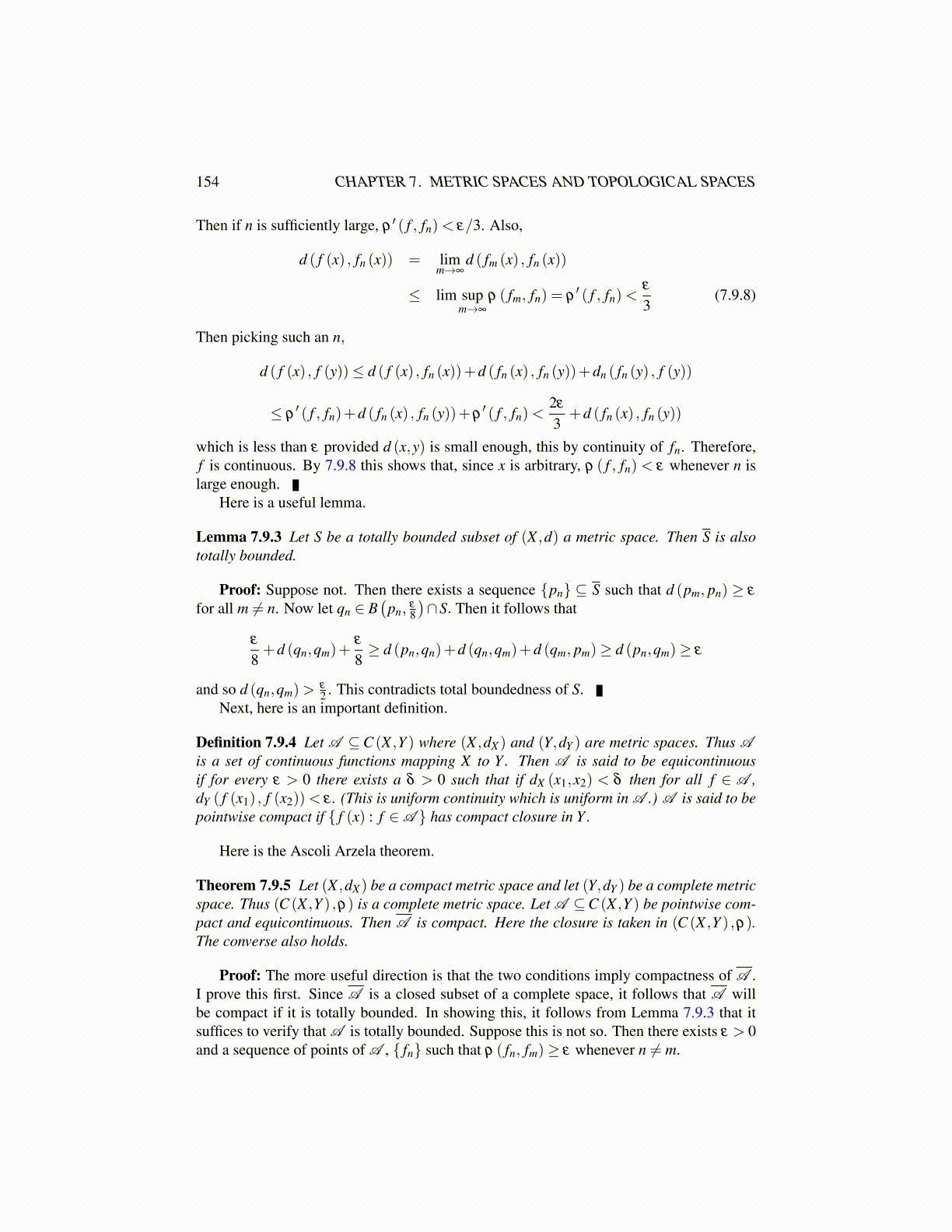
154 CHAPTER 7. METRIC SPACES AND TOPOLOGICAL SPACES
Then if n is sufficiently large, ρ ′ ( f , fn)< ε/3. Also,
d ( f (x) , fn (x)) = limm→∞
d ( fm (x) , fn (x))
≤ lim supm→∞
ρ ( fm, fn) = ρ′ ( f , fn)<
ε
3(7.9.8)
Then picking such an n,
d ( f (x) , f (y))≤ d ( f (x) , fn (x))+d ( fn (x) , fn (y))+dn ( fn (y) , f (y))
≤ ρ′ ( f , fn)+d ( fn (x) , fn (y))+ρ
′ ( f , fn)<2ε
3+d ( fn (x) , fn (y))
which is less than ε provided d (x,y) is small enough, this by continuity of fn. Therefore,f is continuous. By 7.9.8 this shows that, since x is arbitrary, ρ ( f , fn) < ε whenever n islarge enough.
Here is a useful lemma.
Lemma 7.9.3 Let S be a totally bounded subset of (X ,d) a metric space. Then S is alsototally bounded.
Proof: Suppose not. Then there exists a sequence {pn} ⊆ S such that d (pm, pn) ≥ ε
for all m ̸= n. Now let qn ∈ B(
pn,ε
8
)∩S. Then it follows that
ε
8+d (qn,qm)+
ε
8≥ d (pn,qn)+d (qn,qm)+d (qm, pm)≥ d (pn,qm)≥ ε
and so d (qn,qm)>ε
2 . This contradicts total boundedness of S.Next, here is an important definition.
Definition 7.9.4 Let A ⊆C (X ,Y ) where (X ,dX ) and (Y,dY ) are metric spaces. Thus Ais a set of continuous functions mapping X to Y . Then A is said to be equicontinuousif for every ε > 0 there exists a δ > 0 such that if dX (x1,x2) < δ then for all f ∈ A ,dY ( f (x1) , f (x2))< ε . (This is uniform continuity which is uniform in A .) A is said to bepointwise compact if { f (x) : f ∈A } has compact closure in Y .
Here is the Ascoli Arzela theorem.
Theorem 7.9.5 Let (X ,dX ) be a compact metric space and let (Y,dY ) be a complete metricspace. Thus (C (X ,Y ) ,ρ) is a complete metric space. Let A ⊆C (X ,Y ) be pointwise com-pact and equicontinuous. Then A is compact. Here the closure is taken in (C (X ,Y ) ,ρ).The converse also holds.
Proof: The more useful direction is that the two conditions imply compactness of A .I prove this first. Since A is a closed subset of a complete space, it follows that A willbe compact if it is totally bounded. In showing this, it follows from Lemma 7.9.3 that itsuffices to verify that A is totally bounded. Suppose this is not so. Then there exists ε > 0and a sequence of points of A , { fn} such that ρ ( fn, fm)≥ ε whenever n ̸= m.